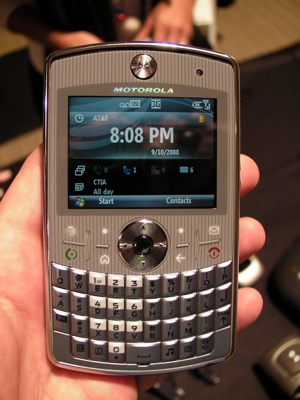Motorola Q9h Silver: Firmware Updates Over the Air, and More on the Q9 Series

Yesterday, when we reported on the Motorola Q11 images, we mentioned that we had some surprising Q9 news. It turns out that our initial dubious reaction to the Dapper Q9h Silver with Pinstripes wasn't really fair -- we got some hints about it during our hands-on at CTIA and arranged to find out what the real deal was with Motorola.
Well, now we know, and what we know is that the Silver Q9h is significantly better than the standard Q9h it's replacing. After the break, find out what's new on the Silver Q9h. Hint: it's there in the title and it's a capital B Big capital D Deal for Windows Mobile.
Also, we explain why on earth Motorola created the EDGE-only Q9e and try our best to lay out all the different versions of the Q9 without the aid of an Excel spreadsheet. Read on!
Firmware Over The Air
By far, the most important new feature on the Q9h Global (Silver) (henceforth Q9hS) is Firmware Over the Air (FOTA) updates. You're reading that right: the Q9hS is able to receive updates over the air that are written to the firmware and persist after a hard reset. Motorola says that AT&T requested the feature and so they baked it into the new Q9hS.
Motorola first hinted at this new feature at CTIA and given how potentially big it could be, I arranged a call with Motorola to confirm that FOTA is actually capable of updating OTA. Motorola claims that it is the real deal. Here's what they told me:
AT&T will administer the FOTA updates. Motorola claims that they're able to use it to add new features and bugfixes -- the example they used was that if AT&T wanted to, say, update the version of AT&T Navigator/Telenav or even the interface for MMS, they simply will place the update on their FOTA server and an alert will be pushed out to your Q9hS. Your phone will then pop up the alert “An update has been received, your device will now verify the update before installing.” Upon accepting the update (you can opt out), the phone will reset and install the new patch to the firmware. Again, Motorola claims that these updates will not be lost after a hard reset.
To clarify one thing: this is not the completely un-utilized “Windows Update” feature found in Windows Mobile 6 and beyond, it is a separate program and presumably requires a mix of software and hardware that is unique to the Q9hS.
All the latest news, reviews, and guides for Windows and Xbox diehards.
Ladies and Gentlemen: if this gets utilized and spread across future Motorola Windows Mobile products, this is the Big Deal we referenced earlier. The ability to push out patches and upgrades is a significant differentiator for both Motorola and AT&T and quite possibly a reason to choose a Q9 over another Windows Mobile device.
I've said elsewhere that the mobile industry needs to do a better job with OTA and I meant it. It's not just OTA, though, it's updates in general. The iPhone has a significant advantage over Windows Mobile in that Apple is able to send out updates to their installed base quickly, easily, and with minimal carrier interference. The 'wait for carrier approval, send out a press release, and hope end users can follow our convoluted firmware update instructions“ situation that Windows Mobile is currently stuck in needs to change.
Now, since AT&T is administering the updates and deciding what (and if) to push out, we suspect that this really won't be the game changer it has the potential to be. However, given the track record of Windows Mobile updates and patches and the difficulty of applying them to a device, I sincerely hope that AT&T and Motorola find a way to license their technology back to Microsoft directly. If nothing else, I hope that AT&T pushes to get this technology across their entire Windows Mobile line and then actually utilizes it for more than just updating their custom AT&T-branded software.
Other New Features in the Q9h Global (Silver)
There are other features of the Q9hS that are significant. A few are throwaway lines like ”this Q9h is the first device on AT&T to ship with Windows Mobile Standard 6.1 installed.“ Others, though, are more important:
Dramatically improved battery life.
Motorola's Q9h has long had an advantage over competing devices like the BlackJack II due to its more powerful processor. This more powerful processor does take a real dent out of battery life, however. Motorola has tackled this issue by allowing the processor to dynamically change its clock speed depending on the situation. When the phone is just idling, it's able to slow down the processor to a speed that's much friendlier on the battery.
Additionally, Motorola claims that the Q9hS is better at managing its 3G connection. It's now more aggressive about turning off the data connection when it's not in use.
The net result is 40% better battery life. Based on a normal user's usage of email, internet, and so on, Motorola claims that the battery life with the slim battery should last most users at least a day and a half and possibly two full days. The extended battery should range from two to three days.
A-GPS
The Q9hS is the first Windows Mobile phone to fully support AT&T's recently implemented A-GPS system, resulting in much faster satellite acquisition. It's notable that this did require a hardware change and won't be made available to the previous generation Q9h.
Crystal Talk
Motorola has also added a feature to the Q9hS they call ”Crystal Talk.“ You can find more information about it at their Crystal Talk website, but the upshot is that Crystal Talk does a much better job at reducing background noise, automatically adjusts your volume, and also has ”voice enhancement.“ This is all done with a custom Digital Signal Processor chip.
Wrapping Up the Q9h Silver
All in all, the Q9h Silver does represent a significant upgrade over the Q9h, but it's a story that isn't really told well by a spec listing. Hopefully all of these new features will find their way to the Motorola Q11 and future devices, but what we're really hoping for are upgrades that can be seen from spec listings: screen resolution comes to mind first.
The Q9 Alphabet Soup
So, now, let's try to clear up what the different versions of the Q9 actually are. We have the official Motorola branding in bold.
- Motorola Q9h, GSM, European version
This Q9h is a GSM Q9 that has the 3G bands necessary for Europe but not the USA. It also lacks GPS. You can identify it easily as it's all black. - Motorola Q9h Global, Rev 1. GSM, AT&T, Rogers, Discontinued on AT&T
This is the Q9h that was originally released on AT&T. It's Tri-Band for GSM and Quad-Band for EDGE, so it should be able to handle 3G pretty much anywhere you take it. This device is also available on Rogers. It has a black front and rear and a silver rail around the edge. This Q9h has been discontinued and replaced by #3. - Motorola Q9h Global, Rev 2. GSM, AT&T ONLY, Silver Pinstripes.
This Q9h has the new look we've mentioned and it replaces #2, the original Motorola Q9h. It will only be available on AT&T and sports a raft of new features that Moto hasn't made clear (until now). - Motorola Q9e, GSM, Small carriers
A GSM Q9 that only has the EDGE radio bands. We wondered why on earth Motorola bothered to create this product and we have the answer: it was requested by several small, local carriers that don't have 3G service. So Moto made it and figured, what they heck, we'll sell it to anybody else that might (inexplicably) be interested. - Motorola Q9m, CDMA, Verizon, Discontinued
The first CDMA Q9, the Q9m on Verizon had a unique, multi-media-focused Today Screen and was Fergie-approved. You can recognize it by its squarish body and red rail. - Motorola Q9c, CDMA, Sprint
The Q9c on Sprint has a weird history -- getting an upgrade to WM6.1 before disappearing for a time due to unspecified 'Technical Issues.' It's back now. - Motorola Q9c, CDMA, Verizon
The replacement for #5, the Motorola Q9m. No significant changes except they tweaked the software so it's more in line with Sprint's Q9c.
WiFi?
Many of our readers have wondered about WiFi in the Q9 series. We know that at least one prototype has it and other versions of the Q9h seem to have chips inside them that support it as well as hooks in the OS to run it. I asked Motorola about this, of course; asked repeatedly, in fact. Sadly and not unexpectedly, Motorola could not comment on the past, present, or future availability of WiFi. Whether it will ever be possible to activate WiFi on current Q9h hardware or if there are more mysterious WiFi-support Q9hs out there will likely remain a mystery.

Home to the most invested and passionate Microsoft fans, Windows Central is the next generation destination for news, reviews, advice and buying recommendations on the Windows, PC and Xbox ecosystems, following all products, apps, software, AI advancements, and accessories. We've been around for more than decade, and we take our jobs seriously. Windows Central writers and editors value accuracy and editorial independence in everything we do, never receiving compensation for coverage and never pulling punches.
